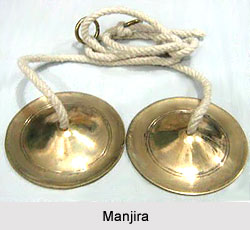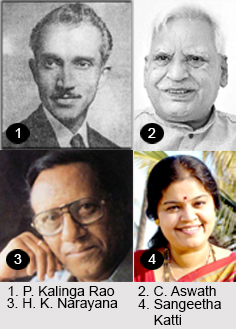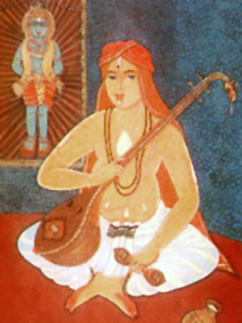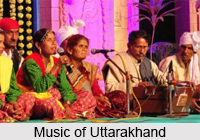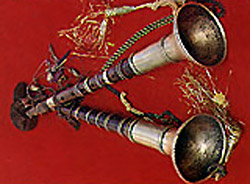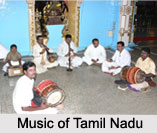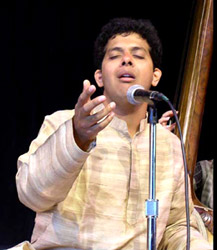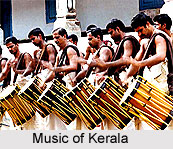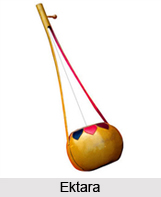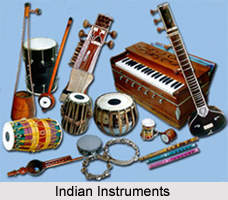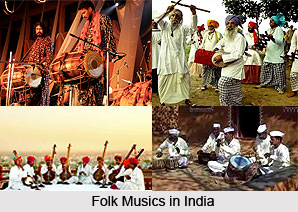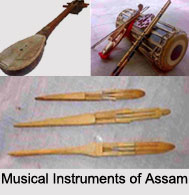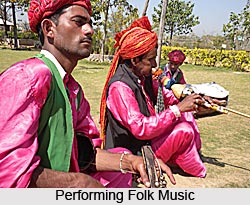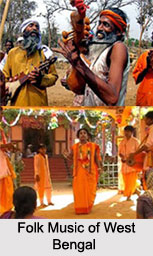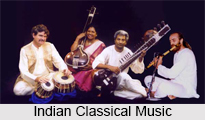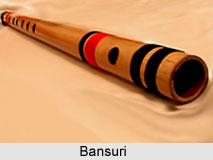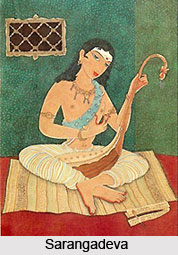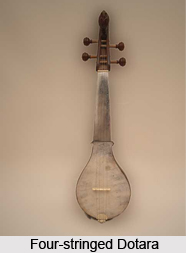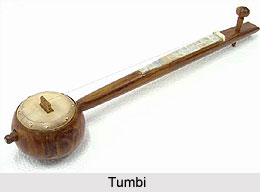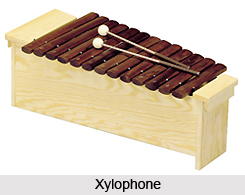Darbari Dhrupad of Baiju was composed by the famous Dhrupad singer Baiju Bawra. The song is performed in the Dagara Bani. It is in Raaga Saurastra Bhairava and its rhythm is Jhapatala. This Raaga is one of the rare Raagas of North India. It belongs to the Bhairava Thata. This Raaga is best suited for performance in the morning.
The Alaap in this Dhrupad performance lasts eight and a half minutes. The Alaap is sung in a three time tempo. In the beginning, it is sung in Vilambita Laya (the slow tempo) and gradually it becomes faster. The point when the singer changes the tempo is indicated by a Thapa (stroke) of Pakhavaj. In the Vilambita Laya the singer shows the Bahutva (importance) of the notes like sa, ma, pa and suddha dha by alahghana. This portion lasts five minutes. The second part of the Alaap is sung in the Madhya Laya (middle tempo). This is the double of the first tempo, the Vilambita Laya. The third or the last portion of Alaap is sung in Druta Laya (fast tempo). It is the double of the previous tempo and four times the first one. This portion like the middle one also starts with Madhya Pa. It ends on Madhya sa. Just before ending the Alaap the singer comes back to Thaha and thus the Alaap comes to an end.
Immediately after the Alaap the first piece of the composition is sung. It is commenced with Madhya Pa. The range of tonal limits in this piece is from mandra komala dha (low Ap) to tdra ma (high F). In the second piece also the singer sings a long Minda similar to that in the first piece. After Antara he sings one Avarta (cycle) of Sthayi then he sings Sanchari and Abhoga in one sequence. The range of tonal limits of Sanchari is from madhya sa to madhya ni. The range of the tonal limits of Abhoga is from mandra komala dha to tara re.
After singing the whole composition in Thaha (the basic rhythm) the singer changes his tempo in such a manner that his Matras (syllables or parts of syllables) now do not coincide with the beats of the drum. As a result of this change in his Laya he accommodates, in nineteen and a half Matras of Tala, the text part that was earlier sung in twenty Matras. There is a slight melodic change in the end of the phrase. He now sings the first Avarta of Sthayi twice. The first time he sings the first note madhya pa (in one Matra by shortening it. Earlier he had sung this note in two Matra but now by singing it in just one Matra he saves one Matra which he utilizes towards the end of the Avarta to bring in an additional note viz. madhya sa. The second time he sings the first note madhya pa with elongation and thus in two Matras. His notes this time are the same as when he sang this Avarta for the second time at the time of beginning his singing. After it he sings the first Avarta of Sanchari without any change in melody. He then sings the whole piece of Sanchari. The melody shows a slight change from previous occasions in the second half of this piece. The Laya (tempo) used in this piece is a complex one. The whole piece which was earlier accommodated in three Avartas is now sung in only two and a half Avartas of Tala. Since each Avarta contains ten Matras, this means that he now sings the text-material, which was earlier accommodated in thirty Matras (three avartas) in only twenty-five Matras (two and a half Avartas). This Laya (tempo) is thus 30/25 or 6/5 times of the basic rhythm.
This is followed by the Mukhda and then the first Avarta of Sthayi. The rhythm at this time is no harmonious with the drum. The notes of the Mukhda show a slight change from before only in its latter half. The notes of the first Avarta are the same as in the beginning of the composition. After this he takes up Sanchari from its middle. The melody of Sanchari is slightly different from before. He sings this part in twenty Matras although earlier he had taken twenty-three Matras to cover the same portion. After this he sings Abhoga. The melody shows only a slight change from previous occasions. This change is mostly on account of different ornamentations of notes that he uses. The Abhoga is sung in Thaha. After Abhoga he repeats the first Avarta of Sthayi. The melody during the singing of the first Avarta of Sthayi shows no change from previous occasions. It is sung in Thaha. The conclusion of this part marks the end of the singing.
